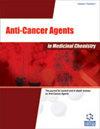用 N-乙酰-D-氨基葡萄糖靶向乳腺癌:整合机器学习和细胞检测,取得可喜成果
IF 2.6
4区 医学
Q3 CHEMISTRY, MEDICINAL
Anti-cancer agents in medicinal chemistry
Pub Date : 2024-02-02
DOI:10.2174/0118715206270568231129054853
引用次数: 0
摘要
背景乳腺癌是一种死亡率很高的常见癌症。早期诊断是降低预后和死亡率的关键。因此,有必要开发替代治疗方案。目的本研究旨在利用机器学习方法研究 N-乙酰-D-葡萄糖胺(D-GlcNAc)对乳腺癌的抑制作用。通过对乳腺癌细胞系的检测进一步证实了研究结果。方法::将 MCF-7 和 4T1 细胞系(ATCC)在不同浓度的 D-GlcNAc(0.5 mM、1 mM、2 mM 和 4 mM)存在和不存在的情况下培养 72 小时。将 4T1 细胞注射到乳腺中,建立了乳腺癌异种移植小鼠模型。每天给小鼠腹腔注射 D-GlcNAc(2 毫摩尔),连续 28 天,并评估瘤前和瘤后阶段的组织病理学效应。结果显示2 mM 和 4 mM D-GlcNAc 能显著降低 MCF-7 和 4T1 细胞系的细胞增殖率,并增加 Fas 的表达。凋亡细胞的数量明显高于未处理的细胞培养物(p < 0.01 - p < 0.0001)。与对照乳腺癌组相比,D-GlcNAc 给药也大大减少了治疗后乳腺癌组的肿瘤大小、有丝分裂和血管生成(p < 0.01 - p < 0.0001)。此外,分子对接/动态分析显示,D-GlcNAc 与标志蛋白 HER2 有很高的结合亲和力,而 HER2 参与肿瘤进展和细胞信号传导。结论我们的研究表明,服用 D-GlcNAc 对乳腺癌细胞有积极影响,可导致细胞凋亡和恶性表型中 Fas 表达的增加。D-GlcNAc 与 HER2 的结合亲和力提示了一种潜在的作用机制。这些发现有助于人们了解 D-GlcNAc 作为一种潜在的抗肿瘤药物对乳腺癌治疗的作用。本文章由计算机程序翻译,如有差异,请以英文原文为准。
Targeting Breast Cancer with N-Acetyl-D-Glucosamine: Integrating Machine Learning and Cellular Assays for Promising Results
Background:: Breast cancer is a common cancer with high mortality rates. Early diagnosis is crucial for reducing the prognosis and mortality rates. Therefore, the development of alternative treatment options is necessary. Objective:: This study aimed to investigate the inhibitory effect of N-acetyl-D-glucosamine (D-GlcNAc) on breast cancer using a machine learning method. The findings were further confirmed through assays on breast cancer cell lines. Methods:: MCF-7 and 4T1 cell lines (ATCC) were cultured in the presence and absence of varying concentrations of D-GlcNAc (0.5 mM, 1 mM, 2 mM, and 4 mM) for 72 hours. A xenograft mouse model for breast cancer was established by injecting 4T1 cells into mammary glands. D-GlcNAc (2 mM) was administered intraperitoneally to mice daily for 28 days, and histopathological effects were evaluated at pre-tumoral and post-tumoral stages. Results:: Treatment with 2 mM and 4 mM D-GlcNAc significantly decreased cell proliferation rates in MCF-7 and 4T1 cell lines and increased Fas expression. The number of apoptotic cells was significantly higher than untreated cell cultures (p < 0.01 - p < 0.0001). D-GlcNAc administration also considerably reduced tumour size, mitosis, and angiogenesis in the post-treatment group compared to the control breast cancer group (p < 0.01 - p < 0.0001). Additionally, molecular docking/dynamic analysis revealed a high binding affinity of D-GlcNAc to the marker protein HER2, which is involved in tumour progression and cell signalling. Conclusion:: Our study demonstrated the positive effect of D-GlcNAc administration on breast cancer cells, leading to increased apoptosis and Fas expression in the malignant phenotype. The binding affinity of D-GlcNAc to HER2 suggests a potential mechanism of action. These findings contribute to understanding D-GlcNAc as a potential anti-tumour agent for breast cancer treatment.
求助全文
通过发布文献求助,成功后即可免费获取论文全文。
去求助
来源期刊

Anti-cancer agents in medicinal chemistry
ONCOLOGY-CHEMISTRY, MEDICINAL
CiteScore
5.10
自引率
3.60%
发文量
323
审稿时长
4-8 weeks
期刊介绍:
Formerly: Current Medicinal Chemistry - Anti-Cancer Agents.
Anti-Cancer Agents in Medicinal Chemistry aims to cover all the latest and outstanding developments in medicinal chemistry and rational drug design for the discovery of anti-cancer agents.
Each issue contains a series of timely in-depth reviews and guest edited issues written by leaders in the field covering a range of current topics in cancer medicinal chemistry. The journal only considers high quality research papers for publication.
Anti-Cancer Agents in Medicinal Chemistry is an essential journal for every medicinal chemist who wishes to be kept informed and up-to-date with the latest and most important developments in cancer drug discovery.
 求助内容:
求助内容: 应助结果提醒方式:
应助结果提醒方式:


